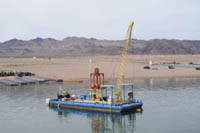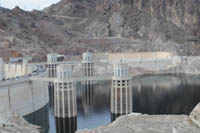Boaters need to be careful this spring as Lake
Mead's water elevation drops. Unmarked reefs are exposed or are just
below the surface of the water. Boating at night or at faster speeds
can be dangerous. Special care also needs to be taken on the launch
ramps. They have been underwater for years and have deteriorated.
Why is the water going
down?
 Lake
Mead stores Colorado River water for delivery to farms, homes and
businesses in southern Nevada, Arizona, southern California and northern
Mexico. About 96 percent of the water in Lake Mead is from melted
snow that fell in Colorado, Utah, New Mexico and Wyoming.
Lake
Mead stores Colorado River water for delivery to farms, homes and
businesses in southern Nevada, Arizona, southern California and northern
Mexico. About 96 percent of the water in Lake Mead is from melted
snow that fell in Colorado, Utah, New Mexico and Wyoming.
Each year, Lake
Mead receives a minimum amount of Colorado River water from these
states, known as the "Upper Basin" states. And each year, a specific
amount of water is released from Lake Mead to users in Nevada, Arizona,
California and Mexico. In an "average" year, the amount of water flowing
out of Lake Mead exceeds the amount of water flowing into Lake Mead.
 In
some years, Lake Mead receives much more than the minimum amount of
water from the Upper Basin, but the amount of water released from
Lake Mead does not vary much from year to year.
In
some years, Lake Mead receives much more than the minimum amount of
water from the Upper Basin, but the amount of water released from
Lake Mead does not vary much from year to year.
The water level
in Lake Mead is lower than it has been in over 40 years.
The water is going
down because the Colorado River runoff for the past four years has
been far below normal.
 In
2000, for example, the runoff was only 56 percent of normal. The runoff
has continued tro be well below normal. Because of this decreased
runoff, Lake Mead has received only slightly more than the minimum
required amount of water from the Upper Basin. But the amount of water
going out from Lake Mead has remained at normal levels. So, there
has been more water going out of Lake Mead in the past four years
than there has been coming into the lake. This causes the elevation
to drop a little more each year.
In
2000, for example, the runoff was only 56 percent of normal. The runoff
has continued tro be well below normal. Because of this decreased
runoff, Lake Mead has received only slightly more than the minimum
required amount of water from the Upper Basin. But the amount of water
going out from Lake Mead has remained at normal levels. So, there
has been more water going out of Lake Mead in the past four years
than there has been coming into the lake. This causes the elevation
to drop a little more each year.
The variation
in water flowing into Lake Mead and the water flowing out of Lake
Mead causes the lake's water level or "elevation" to fluctuate yearly
and over multi-year periods, and has done so throughout the reservoir's
66-year history. This is normal - it is how Lake Mead was designed
to work.
Water is released
from Lake Mead only to meet downstream municipal and agricultural
demands. Consequently, power demands in California, Arizona and Nevada
do not impact its elevation.
Lake Mead is typically
at its highest yearly elevation in the late fall and early spring
months. The lake begins to drop in elevation in the late spring and
early summer when the desert heats up and causes a higher demand of
agricultural and municipal water needed in the Las Vegas Valley, in
Arizona and California, and in Mexico. Some years, the drop is greater
than others, depending on how much difference there is between inflow
and outflow.
If there are several
consecutive years where outflow exceeds inflow, Lake Mead begins each
year with lower water levels, and the elevation continues to drop
until a "wet year" occurs in the Colorado River. Then, Lake Mead typically
receives more water than it releases, and the lake again returns to
higher elevations.
This pattern -
where the lake periodically fills to capacity then experiences a period
of declining levels, only to fill up again - is projected to continue
into the future. But no one can predict the weather, so it is not
possible to predict when the high and low periods will occur.
Information
furnished by the Bureau of Reclamation